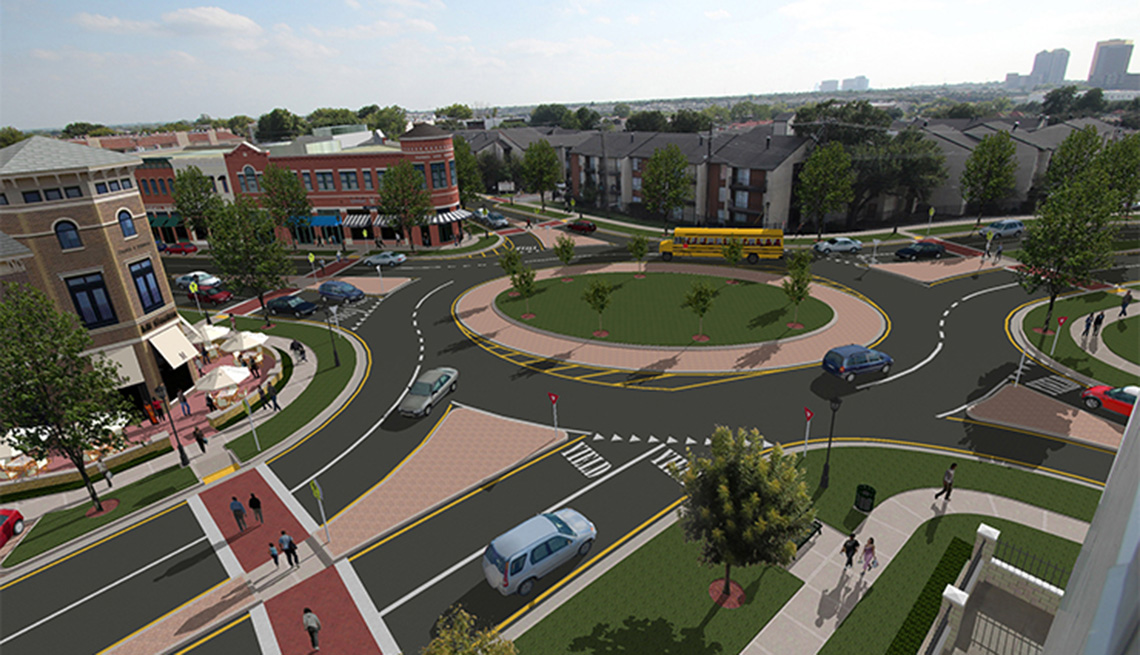
Solutions for urban streets and downtowns, redevelopment, walkability
- Select a language for the TTS:
- UK English Female
- UK English Male
- US English Female
- US English Male
- Australian Female
- Australian Male
- Language selected: (auto detect) - EN
Play all audios:
1. IMPROVING A COMPLEX INTERSECTION DALLAS, TEXAS The landmark Five Points intersection is the front door to one of Dallas' most diverse and transit-oriented neighborhoods. However, the
intersection is complex, with five streets connecting near three-story apartment buildings, a school and retail establishments. The number of turns made by vehicles and the intersection’s
high pedestrian use create numerous points of conflict and a high potential for crashes. THE CHALLENGES * Most development in the area is scaled for cars. * Since the buildings don’t front
the street, they fail to create a sense of enclosure and security for pedestrians. * Overly wide driveways encourage high-speed exits. * Vast expanses of off-street parking diminish a sense
of place. * Sidewalks are "attached" to the curb with no buffer between pedestrians and the cars passing them. The Five Points intersection in Dallas. Photo by the WALC Institute
THE POSSIBILITIES * The Five Points intersection is much simpler and better managed with a modern roundabout. * Rush-hour traffic flow moves smoothly and efficiently and at safe vehicle
speeds. * The roundabout’s truck apron accommodates oversized vehicles. * The placemaking value of the roundabout sets the stage for new buildings and businesses that honor the street and
neighborhood. * Lanes are narrowed and turn lanes are eliminated, making space for on-street parking. * Off-street parking lots are redeveloped into more productive uses. An illustration of
what the Five Points intersection could become. Photovision by the WALC Institute and TDC Design Studio 2. REDESIGNING A DOWNTOWN STREET AUGUSTA, GEORGIA Located within feet of the Savannah
River and a riverwalk trail, this street on the edge of downtown Augusta borders a former railroad depot that’s ready to be redeveloped. The plan presents an opportunity to create a stellar
anchor point for the downtown, provide a destination for residents and visitors and maximize the value of the river and the depot’s proximity to the water. THE CHALLENGES * The street, which
is overly wide for a relatively low volume of traffic, allows cars to pass through at high speeds, which reduces the commercial value of the adjacent properties. * The lack of a mid-block
crossing creates a significant barrier for pedestrians. * This "placeless" street may be suppressing opportunities to redevelop the old rail yard and surrounding parcels. A barren
street in Augusta. Photo by the WALC Institute THE POSSIBILITIES * The street becomes a shared space that better supports all roadway users at all times but can be closed to vehicle traffic
for special events. * Street trees and lighting fixtures add character and are properly scaled for pedestrians and bicyclists. * Street parking, tree wells and bike lanes fit within the
existing right-of-way. * Between 20 and 22 feet are allocated for two vehicle lanes — one in each direction, without a center line. * Bike lanes double as "valley gutters" to help
with stormwater management. * Pervious concrete in the parking lanes also helps to manage stormwater. * Inset parking and tree wells help keep traffic calm. * New development doesn’t turn
its back on the street, but rather faces the street and provides strong connections from the street to the riverwalk. An illustration of what the street could become. Photovision by the WALC
Institute and TDC Design Studio 3. MAKING A RIVERWALK APPROACH MORE WALKABLE NEW ORLEANS, LOUISIANA Residents and tourists alike walk this intersection near the New Orleans Riverwalk.
However, despite the destination’s focus on pedestrian activity, there’s very little support for getting to it by foot or bicycle. Also, practically nothing about the built environment
announces one’s arrival at this special place or draws people from the surrounding streets. Nonetheless, many people do walk and bicycle in the general area, including on the street pictured
here, where vehicle traffic is relatively low most hours of most days. A sense of place and arrival can be created through some simple changes. THE CHALLENGES * The one-way traffic and wide
lanes lead to too fast vehicle speeds. * Sidewalks are narrow and are blocked in several places by utility poles and street trees. (In some spots two people can't walk side by side.) *
Utility wires are unsightly and at odds with the area's historic character. * Crossings at the intersection aren’t marked. * The intersection is wide, and no visual cues are given to
drivers that they should expect to yield to pedestrians. * Ramps don't meet the needs of people with disabilities. A street leading to the New Orleans Riverwalk. Photo by the WALC
Institute THE POSSIBILITIES * Traffic on the street is restored to two-way, with a lane in each direction. * Street parking is kept on both sides of the street, but narrowing the travel
lanes allows one side to be converted to head-out diagonal parking, which increases the number of spots available. * Since New Orleans gets very hot, street trees are added to provide shade
and help reduce the urban heat-island effect. * The colored intersection draws attention to the space as a place for people. * The intersection is raised, which makes it easier for people to
cross and helps keep vehicles slow as they pass through it. * Curb extensions shorten the crossing distance for pedestrians. An illustration of what the street could become. Photovision by
the WALC Institute and TDC Design Studio _EDITOR'S NOTE: The Imagining Livability Design Collection was published in Spring 2015 by AARP Livable Communities and the WALC (Walkable and
Livable Communities) Institute. The institute has since closed shop, but the 40-page publication it helped develop remains a valuable resource for communities and local leaders._ More from
AARP.org/Livable Use the dropdown to choose a livability topic. Select a Subject